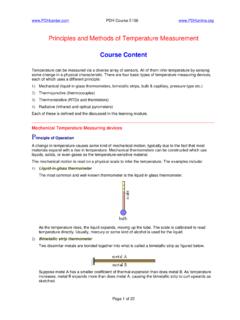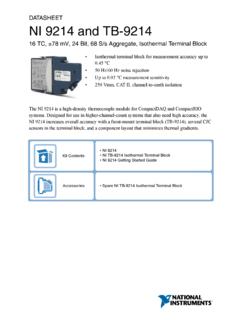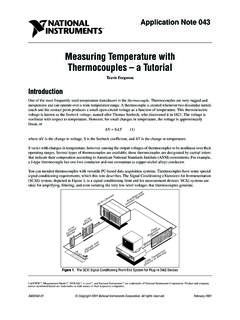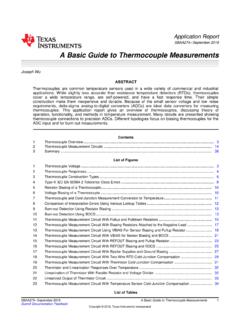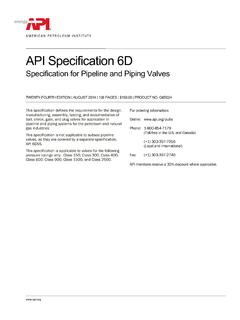Transcription of Temperature Measurement With Thermocouple, RTD and ...
1 - Copyright 2000 - 2022 Dewesoft , all rights reserved. Temperature Measurement With thermocouple , RTD and Thermistor Sensors What is Temperature and different Temperature scales Temperature is a physical property of matter that expresses how hot and cold it is. Did you know that Temperature is the MOST often recorded physical Measurement ? Knowing the Temperature is critical for the correct operation of everything from the human body to an automobile engine, and everything in between. We need to know the Temperature of objects for an almost infinite number of purposes. Temperature is often an indicator that something is wrong: perhaps you have a fever, or the brake pads on your car are about to fail, or a turbine in an energy plant is running too hot. You get the idea. Temperature is measured with one or more kinds of Temperature sensors.
2 There are several available on the market today: thermocouple sensors RTD sensors Thermistor sensors Infrared Temperature sensors The most common scales are the Celsius scale (formerly called centigrade, denoted C), the Fahrenheit scale (denoted F), and the Kelvin scale (denoted K), the last of which is predominantly used for scientific purposes by conventions of the International System of Units (SI). Celsius or centigrade scale which is the most often used scale. For this scale, the freezing point of water is considered to be zero degrees, the boiling point is 100 degrees, and each degree in between is an equal 1/100th of the distance between freezing and boiling. Fahrenheit scale is still widely used in the United States. On the Fahrenheit scale, freezing is 32 degrees and boiling is 212 degrees (180.)
3 Degrees difference). Kelvin scale was created to be more scientific. It is the base unit of thermodynamic Temperature Measurement in the International System (SI) of Measurement . It is defined as 1/ of the triple point (equilibrium among the solid, liquid, and gaseous phases). Graphical comparison of scales: 1. 2. Conversion of Temperature between different scales can be expressed with the following equations: The lowest theoretical Temperature is absolute zero, at which no more thermal energy can be extracted from a body. Experimentally, it can only be approached very closely, but not reached, which is recognized in the third law of thermodynamics. Temperature is important in all fields of natural science, including physics, chemistry, Earth science, medicine, and biology, as well as most aspects of daily life.
4 3. Different types of Temperature sensors thermocouple Sensors Thermocouples are cheap, interchangeable, have standard connectors, and can measure a wide range of temperatures. The main limitation is accuracy. System errors of less than 1 C can be difficult to achieve. A thermocouple is created when two dissimilar metals touch and the contact point produces a small open-circuit voltage as a function of Temperature . You can choose between different types of thermocouples named by capital letters that show their compositions according to American National Standards Institute conventions. The most common thermocouple types of thermocouples include B, E, K, N, R, S, and T . [Video available in the online version]. RTD Sensors - Resistance Temperature Detector An RTD is a device made of coils or films of metal (usually platinum).
5 When the RTD is heated, the resistance of the metal increases; when it gets cooled, the resistance decreases. Passing a current through an RTD generates a voltage across the RTD. By measuring this voltage, you can determine its resistance and that's how its Temperature . The relationship between resistance and Temperature is relatively linear. Typically, RTDs have a resistance of 100 Ohm at 0 C and can measure temperatures up to 850 C. [Video available in the online version]. Thermistor Sensors NOTE: Thermistors are mostly used in electronics circuits and have little practical use when it comes to measuring with Dewesoft. Thus, we shall only give a small overview of them and omit them from further discussion. A thermistor is a piece of semiconductor made of metal oxides that are pressed into a small bead, disk, wafer, or other shape and sintered at high temperatures.
6 Lastly, they are coated with epoxy or glass. As with RTDs, you can pass a current through a thermistor to read the voltage across the thermistor and determine its Temperature . However, unlike RTDs, thermistors have a higher resistance (2,000 to 10,000 Ohm) and much higher sensitivity (~200 Ohm/ C), allowing them to achieve higher sensitivity within a limited Temperature range (up to 300 C). [Video available in the online version]. 4. How do Thermocouples work We already mentioned that thermocouples are the most often used Temperature sensors. A thermocouple is made of at least two metals that are joined together to form two junctions. One is connected to a body whose Temperature will be measured; this is the hot or measuring junction. The other junction is connected to a body of known Temperature ; this is the cold or reference junction.
7 Therefore the thermocouple measures the unknown Temperature of the body with reference to the known Temperature of the other body, which is in line with the Zeroth law of thermodynamics which states that: When two bodies are separately in thermal balance with the third body, then the two are also in thermal balance with each other". Because of this, we need to know the Temperature at the cold junction if we wish to have an absolute Temperature reading. This is done by a technique known as cold junction compensation (CJC). Typically CJC Temperature is sensed by a precision RTD sensor in good thermal contact with the input connectors of the measuring instrument. This second Temperature reading, along with the reading from the thermocouple itself is used by the measuring instrument to calculate the true Temperature at the thermocouple tip.
8 By combining the signal from this semiconductor with the signal from the thermocouple , the correct reading can be obtained without the need or expense to record two temperatures. Understanding cold junction compensation is important since any error in the Measurement of the cold junction Temperature will lead to the same error in the measured Temperature from the thermocouple tip. As well as dealing with the CJC, the measuring instrument must also compensate for the fact that the thermocouple output is non-linear. The relationship between Temperature and output voltage is a complex polynomial equation (5th to 9th order depending on thermocouple type). High accuracy instruments such as Dewesoft instruments store thermocouple tables in devices and compensate the results to eliminate this source of error.
9 [Video available in the online version]. Working principle of Thermocouples Now let's take a look at the working principle of every thermocouple . The working principle is based on the Seebeck, Peltier, or Thomson effect. 1. Seebeck effect prescribes that a circuit made from two dissimilar metal, with junctions at a different Temperature , induces a voltage difference between the junctions. HOT COLD. V. 5. 2. Peltier effect is the opposite of the Seebeck effect. Instead of using heat to induce a voltage difference, it uses a voltage difference to induce heat. Released heat Electron flow +. Electron flow N. Heat flow DC voltage source Absorbed heat Electron flow 3. Thomson effect states that if an electrical current flows along a single conductor while a Temperature difference exists in the conductor, thermal energy is either absorbed or rejected by the conductor, depending on the flow of the current.
10 More specifically heat is liberated if an electric current flows in the same direction as the heat flows; otherwise, it is absorbed. 6. Q Q. COLD COLD. HOT. +. The circuit of every thermocouple must be composed of two dissimilar metals, for example, A and B. These two metals are joined together to form two junctions, p, and q, which are maintained at the temperatures T1 and T2 respectively. Let's not forget, that thermocouple cannot be formed if there is just one junction. If the Temperature of both the junctions is the same, equal and opposite electromotive force will be generated at both junctions and the net current flowing through the junction is zero. If the junctions are maintained at different temperatures, the electromotive force will not become zero and there will be a net current flowing through the circuit.


